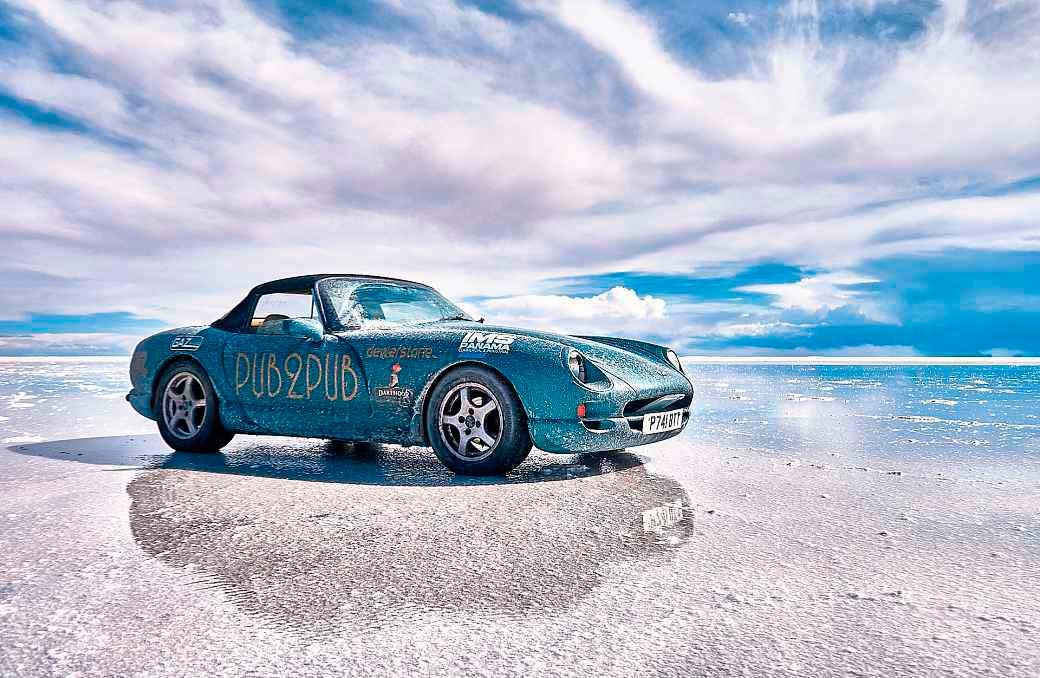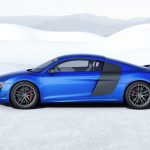
Epic 27,000-mile pub crawl in a TVR Chimaera. What car would you choose for a 27,000-mile jaunt from the world’s most northerly pub to its most southerly? A TVR Chimaera, of course! Surely the definition of an epic drive. Words and photography Ben Coombs.
ACROSS THE WORLD BY TVR | TO THE ENDS OF THE EARTH
From Arctic Circle to Tierra del Fuego by TVR
The roof-down, sundappled cruise to the pub. It’s a cliché, but how far can you push that cliché? What if, in a moment of beer-fuelled optimism, you decide to drive to the bars at the opposite ends of the world?

Well, that’s exactly what I undertook: a 27,000-mile jaunt from the northernmost bar on the planet to the southernmost. Of course, this didn’t come about overnight. Nor am I some foolhardy Victorian-style explorer who launches himself suicidally into the unknown. So far I’ve covered about 90,000 miles in 80 different countries, and always in a vehicle that most would deem inappropriate… that’s half the fun!
‘THE TWO-LANE BLACKTOP RUMBLED TO THE V8 TUNE AS I HEADED ACROSS THE DUST BOWL’
I’ve driven from England to Mongolia in a 1991 Mini, crossed Africa in a Porsche 944 (which resulted in a book, Survival of the Quickest), done England to Singapore in a Corvette and Rolls-Royce Silver Shadow, and explored Morocco in a Rover P6. It was while sitting on a barstool five years ago after getting home from one of my adventures – V8Nam: get a V8, drive to Vietnam, simple – that I had the idea for this trip.
Perhaps surprisingly, the red tape was way simpler than for my trips across Asia and Africa. Travelling on a UK passport, no visas were needed, and most countries operated a rather straightforward ‘Temporary Import Permit’ (TIP) system for the car. Insurance can also be bought at borders rather cheaply. The costs were less easy to rationalise, however. Even by camping, staying in hostels and eating cheaply, the seven-month trip would cost £24,000. It could be part-funded through sponsorship (thanks, Dartmoor brewery and ClassicLine insurance), plus a book and income from Pub2Pub Adventures, a business organising adventurous road trips for others. Maybe.
If the finances weren’t scary enough, then there was my chosen steed for the drive: my trusty, totally standard TVR Chimaera. Because… well, why not?
On paper, it all added up to the ideal trip for a mechanic, but sadly I’m not one. I do have some basic competence, thanks to years of tinkering with cars and doing these trips, but this is an area where I definitely view myself as ‘could do better’.
The starting point was a bar at Pyramiden – an abandoned Soviet mining settlement on the island of Spitsbergen in the Norwegian archepelago of Svalbard, only 700 miles from the North Pole. Just getting there required a 3000-mile drive from England to Tromso, Norway, before a flight into the High Arctic.
It was not as daunting as it sounds. The drive was on good tarmac, and had to be completed in a set time to catch the flight, so I just did it. When there are 27,000 unknown miles ahead, a relatively unchallenging 3000 to kick it off is nothing to fret about. In fact, it was a nice shakedown for the TVR.
After Pyramiden, all roads led south. Literally. For day after day, I cruised down through Norway; mountains and fjords competing for attention. I re-crossed the Arctic Circle and rolled on through breathtaking mountains into Sweden, where the landscape’s oscillations reduced as Scandinavia’s southern reaches beckoned. Northern Europe then passed beneath the unexpectedly reliable wheels, punctuated with visits to various points of interest along the way. Points such as Ferropolis, Germany, with its retired behemoths of the open-cast mining world, and Chantilly, France, where I met Porsche legend Philippe Delaporte and his globetrotting 928.
‘IN MEXICO, THE WORLD CHANGED. I FELT RATHER CONSPICUOUS IN A SHOUTY GREEN BRITISH SPORTS CAR’
Then, at Southampton, after 6250 miles, the expedition went transatlantic and the TVR was shipped to the New World. We met again 3500 miles away in the port of New Jersey. Getting the car to the US wasn’t the easiest of jobs.
Also, because I shipped the car ‘Roll on- Roll off’ rather than in a container, I wasn’t able to leave anything in it for the Atlantic crossing. That meant the tools and spares brought from England were limited to what I could carry on the ’plane across the Atlantic in hold luggage. Oh well, only 20,000 miles to go…
And so began the Chimaera’s extended vacation on the American landmass. Rolling out of the port in perhaps the only Wheelerera TVR in the USA, roof-down as the Manhattan skyline and Statue of Liberty flashed past, was a pretty serious life tick. Under a continuous barrage of thumbs-up from appreciative locals, I put the New York skyline in the rear-view mirror and set off east, first to Washington, then on to West Virginia’s Skyline Drive and the Appalachian Mountains, where some of North America’s most glorious driving roads lie smothered beneath a 35mph speed limit.
Such restrictions are doubly frustrating when you need to push on to catch a total solar eclipse in Tennessee. But I made it, before striking out along I-40. This two-lane blacktop rumbled to the V8 tune as I headed across the Dust Bowl plains of Arkansas and Oklahoma to Amarillo, Texas, where I dropped in on a grassroots Sunday-morning drag-race and ran the quarter-mile, logging the slowest time of the day in the process.
Soon the landscape got its game on, morphing into the American West we all know from a thousand movies. And I wasn’t afraid to entertain a few clichés. Like going roof-down in Monument Valley, bouncing the exhaust note off the walls of Zion Canyon, cruising nonchalantly down the Las Vegas strip or popping up to Rachel, Nevada, tucked away next to Area 51.
Then Death Valley beckoned. That’s Death Valley in mid-summer. All 50ºC of it, and the toughest test yet for the TVR. Blackpool’s finest took the arid, salty landscape in its stride, with no overheating and little complaint when faced with corrugated desert tracks. In California I diced with Porsche 911s on the Pacific Coast Highway, camped among the Joshua Trees of the Mojave Desert, and rolled through Beverly Hills, but all the while I felt the jungles of Central America calling.
Aross the border into Mexico, the world changed. The traffic became frenzied, kicking up dust between the battered buildings. Police pick-up trucks proliferated, machine guns mounted on their rollcages, while army vehicles pushed through the melée. I felt rather conspicuous in a shouty green British sports car – only a few people on this continent knew what it was, some from Gran Turismo, others through watching old Top Gear episodes. For them, a TVR was a mythical, angry beast from across the seas.
South across vast grassy plains and through mountain ranges to the Pacific beaches around Mazatlán, then on to the Mayan ruins that erupt from the jungle. Road conditions deteriorated, with mountainous speedbumps the ‘terrain’ that gave the TVR the most trouble on this trip despite at least 400 miles of unsealed gravel roads. Police checkpoints were regular, and all – predictably – showed interest in the TVR.
Having arrived at El Salvador to discover that right-hand-drive cars are illegal, I had to transit the country within 24 hours on a special permit by claiming to be a delivery driver taking the car to Honduras. I paused in Managua to change the TVR’s tired clutch – the only major job it required on the entire adventure. The frenzied traffic of the Nicaraguan capital was also where my only collision took place, when a taxi hit the rear three-quarter, scratching the glassfibre.
Costa Rica was even more averse to right-hand- drive vehicles than El Salvador and I had to arrange for a truck to carry the car across the country to Panama. But because the driver didn’t have the correct paperwork to complete the international transit and Nicaragua refused me re-entry, for eight days I was stuck between the borders, before finding another lorry going the right way. I loaded the car, completed the paperwork, and rolled away into the Costa Rica night. Except that Costa Rica’s customs complained to Panama about the TVR’s (completely legal) passage and they refused permission to unload the TVR. Oh well.
More hours of impasse followed, but the expedition had made some friends in high places. It’s amazing how helpful a border official can be when the Office of the Vice President calls up and ‘suggests’ they let the little English car in! I was back on the road for the first time in 11 days and, after a few days enjoying the scenery, it was time to drop off the TVR for its next sea passage past the impenetrable Darien Gap, to Colombia.
With Central America behind me, the first foray into South America offered pleasure and pain in equal measure. Pain from the day-and-a-half it took to get the car released from Cartagena; pleasure from the wonderful people, landscapes, towns and vibrant classic car culture. For Christmas at an Englishowned hostel, we upheld the tradition of Boxing Day Races by pitting the TVR against the hostel’s horse across a muddy field.
On the flip-side were the tortuous mountain roads on which a 20mph average was to be cherished, and a political landscape that, despite current stability, left you fearing that anything could happen.
Ecuador was next and threw up surprise after surprise. Moments such as dropping out of the twisting chaos of Quito, to be greeted by the 5900m-high pyramid of the Cotopaxi volcano, shimmering in the dusk. Or rocketing through the plunging canyons in the south of the country. Or even meeting up with the local Japanese Car Club, and its fleet of pristine Datsun pick-ups in Cuenca.
In Peru, more than 40 hours of driving lay between the border town of Huaquillas and the Bolivian frontier. And the first 20 presented a parched landscape, as smooth tarmac sliced through the sand while rubbish eddied in my slipstream. The second workshop visit of the trip took place in Lima, where rough running was traced to faulty resistors in the high-tension circuit. The car was soon ready for the final run down to that southernmost pub.
From Lima to Nazca, the odyssey took on a different dimension: a vertical one. A series of stacked hairpins and sweeping turns took me up onto the Altiplano, more than 4km above sea level, cruising past snowcapped peaks, lonely lakes and herds of llamas. It was rainy season up there, and I rolled on through the downpours towards Lake Titicaca, skirting around it on the way to the Bolivian border. Except I ran into road blocks in eastern Peru, where villagers were protesting about the arrest of their political leader by closing the main road.
Bolivia offered the opportunity to drive the fabled ‘Death Road’ to the north of La Paz. This unlikely 64km passage drops in altitude from 4700m to 1300m, and for most of its distance consists of a narrow gravel track clinging to the edge of a cliff. Bolivia is also home to the largest salt flat on the planet – the endless expanse of the Salar de Uyuni.
Because it was flooded with an inch of water when I arrived, it had become the largest mirror in the world. The sensation of driving through the sky is a most surreal experience. From Uyuni, 120 miles of gravel tracks led to Chile and the driest landscape on Earth: the Atacama Desert. For 1000 miles, I passed through a world that was baked dry of life, before green reappeared in Patagonia. For day after day I cruised its vastness on Ruta 40, often more than 100 miles between settlements, with one everpresent thought: ‘Please don’t break down here.’
From then on, every glance at the roadmap suggested I was closing in on my goal, as the continent narrowed and the churning seas of Cape Horn came ever closer. I had to take to those seas in order to reach the bar on the island of Puerto Williams, near the tip of Tierra del Fuego. The end of the world.
And there was time to reflect as we sailed for a day-and-a-half. My journey had taken in everything from high Arctic tundra to dense rainforest; barren desert to smog-choked city. Altitudes ranged from -86m in Death Valley to 4700m in the Bolivian Altoplano, temperature from sub-zero in the High Arctic to over 50°C in Death Valley. Conditions included cyclone season in Central America, the driest desert on earth and the occasional snowstorm. Petrol ranged from European ’1998 to filthy, low-octane Bolivian stuff, which needed a bottle of octane booster chucked in. My companions were similarly varied, as people joined me at various intervals. In Europe, I travelled in convoy with friends in a Nissan Micra, while others flew out and bought a tasteless 2006 Hemi Dodge Charger, in a virulent shade of Trump orange, to convoy from New York to Costa Rica.
While a second vehicle was present for much of the trip except South America, I wouldn’t describe them as ‘support vehicles’ because no ‘support’ was ever offered to the Chimaera, and generally the second car faired worse, especially the unreliable Dodge.
The only constant, therefore, was the beer. And I can tell you it never tasted better than that pint at the bottom of the world.
‘MY JOURNEY HAD TAKEN IN EVERYTHING FROM HIGH ARCTIC TUNDRA TO DENSE RAINFOREST’
FOR MORE on the Pub2Pub Expedition and other trips, visit www.pub2pubexpedition.com / IMAGES ÁLVARO ANDRÉS PINZÓN, ANDRESPINZOOM.COM
Clockwise from Left Crossing the Arctic Circle; exploring a dried-up lake near Area 51 in Nevada, USA; Germany’s mining past at Ferropolis, near Berlin; Arctic Norway under the midnight sun. Below Leaving the tarmac in the Valley of the Gods, Utah, USA; beneath the Golden Gate Bridge; dropping into the world’s longest-running cars and coffee meet in Phoenix, Arizona.
Clockwise from below Changing the clutch in Managua, Nicaragua – the only major work the TVR required during its 27,000-mile trip; a pause in Panama City; rounding a corner to come face-to-face with the 5897m Cotopaxi Volcano in Ecuador. Above and right Passing a train in rural Ecuador; beware the sheep of southern Bolivia when en-route for the Chilean border; on the edge, descending Bolivia’s infamous Death Road. Clockwise from far left Out on the Salar de Uyuni – Bolivia’s famous salt flats; author Ben and the TVR on Bolivia’s Death Road – and its ominous welcome; letting the ferry take the strain; essential roadside maintenance; derelict steam locomotives in the desert near Uyuni.
‘STACKED HAIRPINS AND SWEEPING TURNS TOOK ME UP ONTO THE ALTIPLANO, MORE THAN 4KM ABOVE SEA LEVEL’







